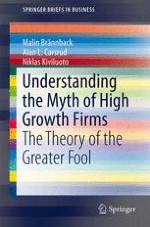2014 | OriginalPaper | Chapter
5. Growth and Profit
Authors : Malin Brännback, Alan L. Carsrud, Niklas Kiviluoto
Published in: Understanding the Myth of High Growth Firms
Publisher: Springer New York
Activate our intelligent search to find suitable subject content or patents.
Select sections of text to find matching patents with Artificial Intelligence. powered by
Select sections of text to find additional relevant content using AI-assisted search. powered by
